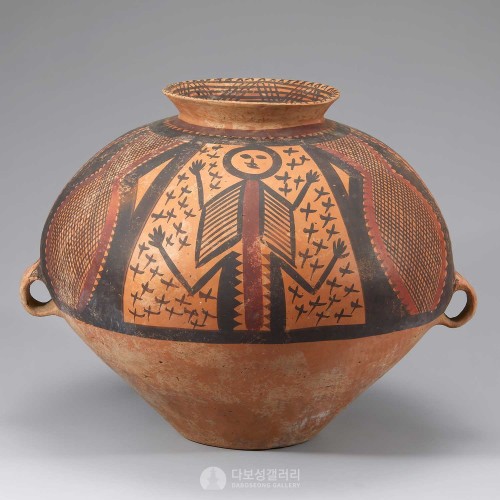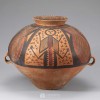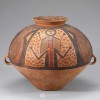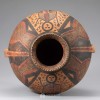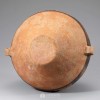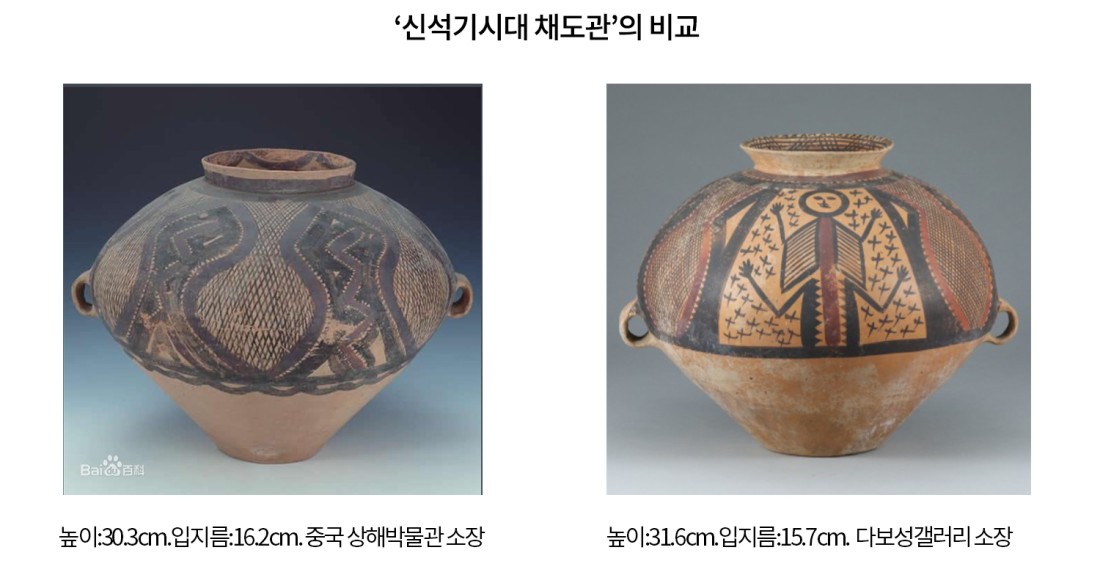본문
신석기시대에 중국에서 만들어진 채색도자 인물무늬 쌍이관입니다.
몸통의 양쪽에 동그란 모양의 두 귀가 달려 있고, 몸통의 위쪽에는 검은색과 검붉은색으로 그려진 인물과 교차된 직선 등 기하학적 무늬가 그려져 있습니다. 관은 항아리를 뜻합니다.
중국에서 흙으로 그릇을 만드는 토기 문화는 신석기시대에 시작되어 도기 문화로 발전했습니다. 신석기시대의 중국 도기는 황하(黄河) 유역과 장강(長江) 유역·동남해안·북방 유역 등으로 광범위하게 분포합니다. 황하와 장강 중상류 지역은 채도로 유명하고, 하류 지역은 정교한 백도기(白陶器)와 흑도기(黑陶器)로 유명하며, 동남해안 지역은 경도기(硬陶器)로 대표되고, 북방 지역은 특색 있는 조형도기로 유명합니다. 신석기 도기는 제작 방법에 따라 수제(手製)·모제(模製)·완륜(慢輪)·쾌륜(快輪)으로 나뉘며, 문양으로는 압인(壓印)·박인(拍印)·각화(刻畵)·채색(彩繪)·누공(鏤孔)으로 나뉩니다. 제작 가마로는 횡혈요·수혈요가 있습니다. 이처럼 다양한 신석기시대의 다양한 도기문화는 오늘날 도자기의 모태가 되었습니다.
중국 신석기시대의 토기는 지역에 따라 다양한 양상을 보이는데, 채도(彩陶)는 앙소(仰韶) 문화를 비롯해 중국 신석기문화의 대표적인 토기로 대부분 붉은색 토기 표면에 검은 선으로 무늬를 그렸습니다. 무늬는 주로 기하학 무늬나 당시 사람들이 접촉했던 물고기, 새, 개구리, 돼지 등을 소재로 표현했습니다.
━━━━━
这是在新石器时代中国制造的彩陶人物纹双耳罐,腹部两侧各有一对圆耳,罐上部绘有黑、暗红图形、交叉直线等几何图案。罐是坛子。
中国新石器时代的陶器分布相当广泛,其主要分布区域有黄河流域、长江流域、东南沿海及北方地区等。黄河、长江中上游地区以彩陶闻名,下游地区以工艺精湛的白陶和黑陶著称;东南沿海地区以印纹硬陶为代表;北方地区则以富有民族特色的造型陶器称奇。陶器是原始时期极为重要的创造。新石器时代生活在中国境内的原始先民们发明了制陶技术,开始使用陶器。各地区的陶器都有其独特之处,但相互之间又存在着内在的联系。新石器时代的陶器,从陶质区分,有红陶、灰陶、黑陶、白陶和彩陶;从工艺上区分,有手制、模制、慢轮、快轮;从纹样上区分,有压印、拍印、刻画、彩绘、镂孔;从陶窑区分,有横穴窑与竖穴窑。正是这些风格迥异,各不相同的类别,创造了新石器时代绚丽多姿的陶器文化。
中国新石器时代的陶器因地域不同而呈现出不同的样子。彩陶是中国新石器文化包括仰韶文化的代表性陶器,纹理多为红底黑线花纹。图案也主要表现为当时人们接触到的几何图案或鱼、鸟、蛙、猪等。
━━━━━
A painted pottery neolithic two-handled 'figural' jar produced in the neolithic era. A pair of loop handles are on both sides of the body, and black, dark red figures and geometric patterns like cross-hatches are on the upper body.
Chinse pottery began in the Neolithic period and developed into earthenware. Neolithic Chinese earthenware is widely distributed along the Yellow River, the Yangtze River, the southeast coast, and the northern basin. The upper-middle areas of the Yellow River and Yangtze River are known for painted pottery, the downstream area is known for elaborate white pottery and black pottery, the southeast coastal area is represented by hard pottery, and the northern region is famous for its distinctive shaped pottery. It is also divided into the hand-made, mold-made, slow wheel, and the fast wheel by production method. The patterns are divided into stamped, printed, engraved, painted, and perforated. Kiln types include horizontal kilns and vertical kilns. As such, various pottery cultures of the Neolithic Age became the beginning of pottery today.
Chinese neolithic pottery varies depending on region, and painted pottery (彩陶, caitao) is the most representative pottery, in the form of red pottery with black patterns on the surface, in Chinese neolithic culture, such as the Yangshao culture. Patterns are usually depicted with animals that people of the time frequently encountered, such as fish, birds, frogs, pigs, and so on.
